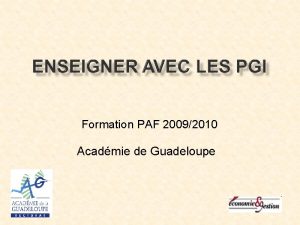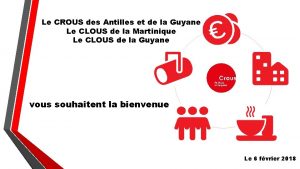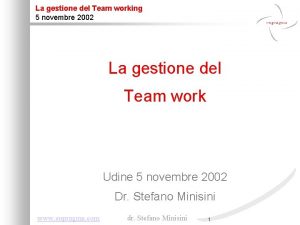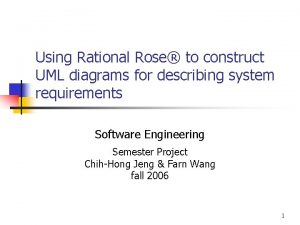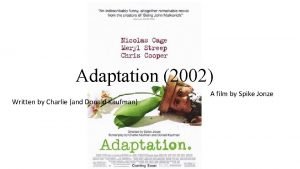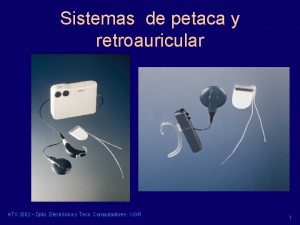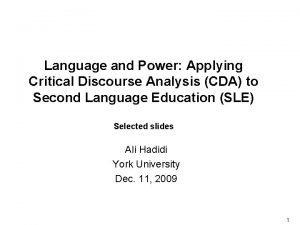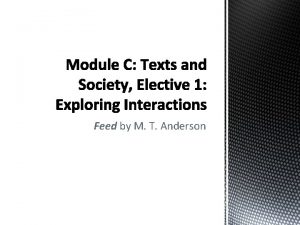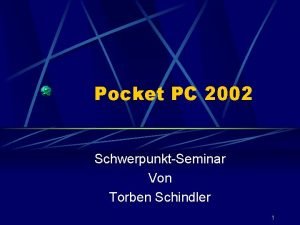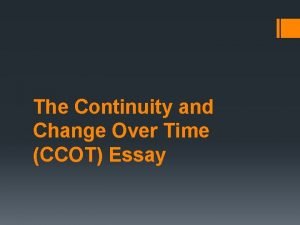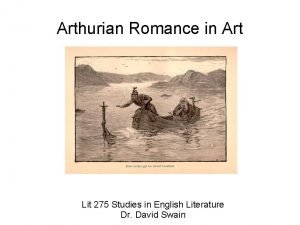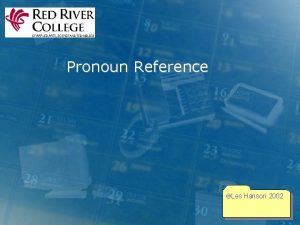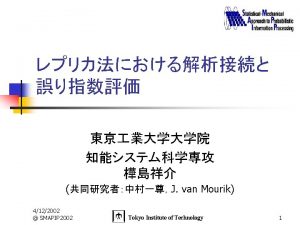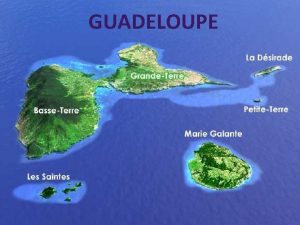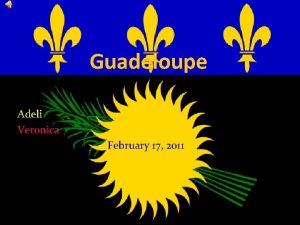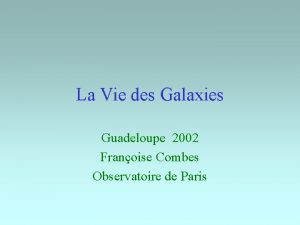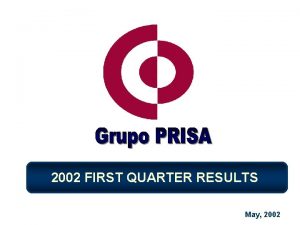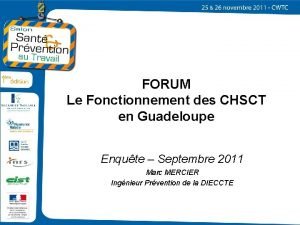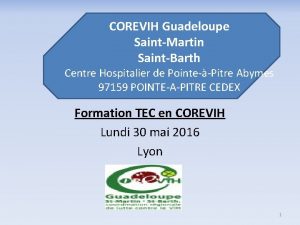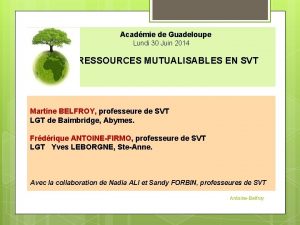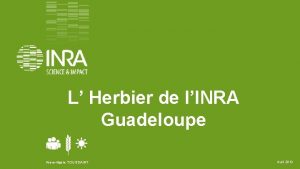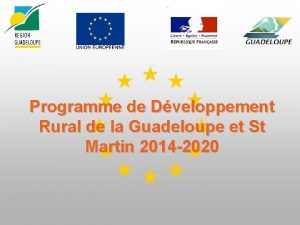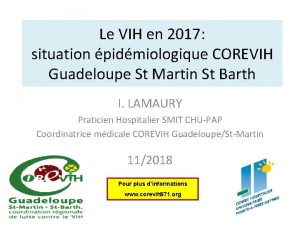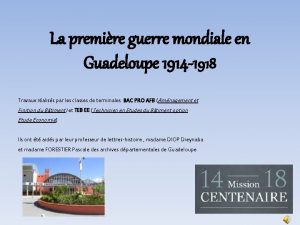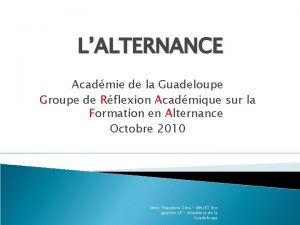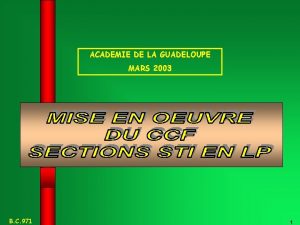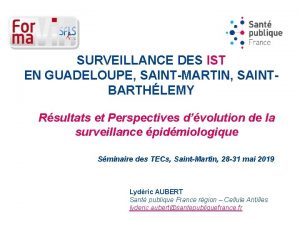PAREO 2002 Guadeloupe May 20 24 2002 A



































- Slides: 35

PAREO 2002 Guadeloupe, May 20 -24, 2002 A Parallel GRASP with Path-Relinking Heuristic for the 2 -Path Network Design Problem Celso C. RIBEIRO Isabel ROSSETI Gosier, Guadeloupe May 2002 1 Catholic University of Rio de Janeiro Brazil Parallel GRASP with PR for the 2 -path network design problem

Summary • Problem formulation • GRASP with path-relinking heuristic – Construction phase – Local search phase – Path-relinking • Parallel implementation – Independent strategy – Cooperative strategy • Computational results • Concluding remarks May 2002 2 Parallel GRASP with PR for the 2 -path network design problem

2 -path network design problem • Graph G = (V, E) V: node set E: edge set weights we associated with each edge e E • k-path between nodes s, t V: sequence of at most k edges connecting s and t • D: set of demands (origin-destination pairs) May 2002 3 Parallel GRASP with PR for the 2 -path network design problem

2 -path network design problem • 2 -path network design problem (2 PNDP): Find a minimum weighted subset of edges E’ E containing a 2 -path in G between the extremities of every origin-destination pair in D • Applications: design of communication networks, in which paths with few edges are sought to enforce high reliability and small delays May 2002 4 Parallel GRASP with PR for the 2 -path network design problem

2 -path network design problem • Dahl & Johannessen (2000): – Decision version of 2 PNDP is NP-complete. – Approximate algorithm – Exact cutting plane algorithm • Balakrishnan & Altinkemer (1992): – Integer programming formulation for k. PNDP – See also Le. Blanc, Chifflet & Mahey (1999). • Generalizations: k-hop minimum spanning tree, k-hop minimum Steiner tree May 2002 5 Parallel GRASP with PR for the 2 -path network design problem

GRASP with path-relinking • GRASP: – Multistart metaheuristic: Feo & Resende (1989) • Path-relinking: – Intensification strategy: Glover (1996) • Repeat for Max_Iterations: – – – May 2002 Construct a greedy randomized solution Use local search to improve the constructed solution Apply path-relinking to further improve the solution Update the pool of elite solutions Update the best solution found 6 Parallel GRASP with PR for the 2 -path network design problem

GRASP with path-relinking • GRASP – Construction phase 1. Set the modified weights equal to the original weights. 2. Randomly select an origin-destination pair (a, b) D. 3. Compute a shortest 2 -path between a and b using the modified weights. 4. Set to 0 the modified weights of the edges in this path. 5. Remove (a, b) from D. 6. If D is empty stop, otherwise go back to step 2. May 2002 7 Parallel GRASP with PR for the 2 -path network design problem

GRASP with path-relinking • GRASP – Local search phase 1. Generate a circular random permutation of the pairs in D. 2. Select the next origin-destination pair (a, b) D. 3. Tentatively replace the shortest 2 -path between a and b: • • May 2002 Weights of edges used by other 2 -paths are temporarilly set to 0. Compute a new shortest 2 -path between a and b. Update the current solution if it is improved by the new 2 -path. Restore all original edge weights. 4. If |D| 8 paths have been investigated without Parallel GRASP with PR for the 2 -path network design improvement stop, otherwise goproblem back to step 2.

GRASP with path-relinking • Path-relinking: introduced in the context of tabu search by Glover (1996) – Intensification strategy using set of elite solutions • Consists in exploring trajectories that connect high quality solutions. initial solution May 2002 path in neighborhood of solutions 9 guiding solution Parallel GRASP with PR for the 2 -path network design problem

GRASP with path-relinking • Path is generated by selecting moves that introduce in the initial solution attributes of the guiding solution. • At each step, all moves that incorporate attributes of the guiding solution are evaluated and the best move is taken: guiding solution Initial solution May 2002 10 Parallel GRASP with PR for the 2 -path network design problem

GRASP with path-relinking Elite solutions x and y (x, y): symmetric difference between x and y while ( | (x, y)| > 0 ) { evaluate moves corresponding in (x, y) make best move update (x, y) } May 2002 11 Parallel GRASP with PR for the 2 -path network design problem

GRASP with path-relinking • Maintain an elite set of solutions found during GRASP iterations. • After each GRASP iteration (construction and local search): – Select an elite solution at random: guiding solution. – Use GRASP solution as initial solution. – Perform path-relinking between these two solutions. 12 May 2002 Parallel GRASP with PR for the 2 -path network design problem

GRASP with path-relinking • Successful applications: – Prize-collecting Steiner tree problem: Canuto, Resende & Ribeiro (2001) – Minimum Steiner tree problem: Ribeiro, Uchoa & Werneck (2002) (e. g. , best known results for open problems in series dv 640 of the Stein. Lib) – Three-index assignment problem: Aiex et al. (2000) – Capacitated minimum spanning tree: Souza, Duhamel & Ribeiro (2002) (e. g. , best 13 May 2002 Parallel GRASP with PR for the 2 -path network design known results for largest problems problemwith 160

GRASP with path-relinking • P is a set of elite solutions. • Each iteration of first |P| GRASP iterations adds one solution to P (if different from others). • After that: solution x is promoted to P if: – x is better than best solution in P. – x is not better than best solution in P, but is better than worst and is sufficiently different in Parallel P. GRASP with PR for the 2 -path network design 14 May 2002 from all solutions problem

May 2002 15 Parallel GRASP with PR for the 2 -path network design problem

Parallel implementation • Main interest of parallel implementations of metaheuristics: robustness Cung, Martins, Ribeiro & Roucairol (2001) • Multiple-walk independent-thread strategy: – p processors available – Iterations evenly distributed over the p processors – Each processor keeps a copy of the algorithm and data – One processor acts as the master (data, seeds, iterations), but also performs GRASP iterations – Each processor performs Max_Iterations/p iterations May 2002 16 Parallel GRASP with PR for the 2 -path network design problem

Parallel implementation: independent seed(1) seed(2) Elite 1 seed(3) Elite 3 2 p seed(p) 17 Elite 4 Elite May 2002 seed(4) seed(p-1) Elite p-1 Best solution is sent to the master Parallel GRASP with PR for the 2 -path network design problem

Parallel implementation • Main interest of parallel implementations of metaheuristics: robustness Cung, Martins, Ribeiro & Roucairol (2001) • Multiple-walk cooperative-thread strategy: – p processors available – Iterations evenly distributed over p-1 processors – Each processor keeps a copy of the algorithm and data – One processor acts as the master (data, seeds, iterations) and controls the pool of elite solutions – Each slave processor performs Max_Iterations/(p-1) May 2002 Parallel GRASP with PR for the 2 -path network design iterations 18 problem

Parallel implementation: cooperative Master Elite solutions are stored in a centralized pool Elite 1 2 Slave May 2002 p 3 19 Slave Parallel GRASP with PR for the 2 -path network design problem

Computational results • Parallel GRASP heuristic: – Implementation in C – MPI LAM 6. 3. 2 for communication – Linux cluster with 32 Pentium II-400 processors • Largest instances solved: – Larger instances solved with the GRASP heuristic: |V|= 400, |E|= 79800, |D|= 4000 (previously: |V|= 120, |E|= 7140, |D|= 60) May 2002 20 Parallel GRASP with PR for the 2 -path network design problem

Computational results • Effectiveness: – 100 small instances with 70 nodes generated as in Dahl and Johannessen (2000) for comparison purposes. – Statistical test t for unpaired observations – Parallel GRASP finds better solutions with 40% of confidence. May 2002 21 Parallel D&J GRASP (2000) Size Sample A Sample B 100 30 Mean 443. 7 ( 453. 7 -2. 2%) Std. dev. 40. 6 61. 6 Parallel GRASP with PR for the 2 -path network design problem

Variants of GRASP with path-relinking • Variants of GRASP with path-relinking: – – T S GRASP: pure GRASP G+PR(B): GRASP with backward PR S G+PR(F): GRASP with forward PR G+PR(BF): GRASP with two-way PRS T: elite solution S: local search • Other strategies: S – Truncated path-relinking – Do not apply PR at every iteration (frequency) May 2002 22 Parallel GRASP with PR for the 2 -path network design problem T T T

Variants of GRASP with pathrelinking • Select an instance and a target value. • For each variant of GRASP with pathrelinking: – Perform 200 runs using different seeds. – Stop when a solution value at least as good as the target is found. – For each run, measure the time-to-target-value. – Plot the probabilities of finding a solution at least as good as the target value within some time. Parallel GRASP with PR for the 2 -path network design 23 May 2002 computation problem

Variants of GRASP with pathrelinking Each variant: 200 runs for one instance of 2 PNDP May 2002 24 Parallel GRASP with PR for the 2 -path network design problem

Variants of GRASP with pathrelinking • Same computation time: probability of finding a solution at least as good as the target value increases from GRASP G+PR(F) G+PR(BF) • P(h, t) = probability that variant h finds a solution as good as the target value in time no greater than t – P(GRASP, 10 s) = 2% P(G+PR(F), 10 s) = 56% P(G+PR(B), 10 s) = 75% P(G+PR(BF), 10 s) = 84% • Effectiveness of path-relinking to improve and 25 May 2002 Parallel GRASP with PR for the 2 -path network design problem speedup the pure GRASP

Independent strategy: speedups • Linear speedups: |V|= 400, 3200 iterations, G+PR(BF) May 2002 26 Parallel GRASP with PR for the 2 -path network design problem

Cooperative vs. independent strategy Independent Cooperative • Solution quality Procs. best avg. • Same instance: 1 520 525. 4 15 runs with 2 519 524. 5 519 526. 4 different seeds, 3200 iterations 4 527. 8 521 526. 3 • The pool is poorer 8 524 529. 5 521 526. 5 when fewer 533 535. 1 515 525. 0 GRASP iterations 16 are performed 32 538 541. 2 521 526. 3 May 2002 27 Parallel GRASP with PR for the 2 -path network design problem

Cooperative vs. independent strategy Procs. Indep. Coop. 1 May 2002 28 1358. 5 - 2 682. 2 2192. 1 4 333. 0 740. 4 8 165. 0 312. 4 16 81. 6 197. 9 32 41. 2 182. 7 Parallel GRASP with PR for the 2 -path network design problem

Cooperative vs. independent strategy • Select an instance and a target value. • For each strategy: – Perform 100 runs using different seeds (not all runs already performed). – Stop when a solution value at least as good as the target is found. – For each run, measure the time-to-target-value. – Plot the probabilities of finding a solution at least as good as the target value within some computation time. 29 May 2002 Parallel GRASP with PR for the 2 -path network design problem

Cooperative vs. independent strategy May 2002 30 Parallel GRASP with PR for the 2 -path network design problem

Cooperative vs. independent strategy May 2002 31 Parallel GRASP with PR for the 2 -path network design problem

Cooperative vs. independent strategy May 2002 32 Parallel GRASP with PR for the 2 -path network design problem

Cooperative vs. independent strategy • Recall that when p processors are used: – All of them perform GRASP iterations in the independent strategy – Only p-1 processors perform GRASP iterations in the cooperative strategy • Cooperative strategy improves w. r. t. the independent strategy when the number of processors increases. • Cooperative strategy is already faster for p 4 processors. May 2002 33 Parallel GRASP with PR for the 2 -path network design problem

Concluding remarks • New heuristic for the 2 -path network design problem. • Effectiveness of the new heuristic: – Larger problems solved. – New heuristic finds better solutions. – Domination is stronger for harder or larger instances. • Path-relinking adds memory and intensification mechanisms to GRASP, systematically contributing to improve solution quality (some implementation strategies appear to be more effective than others). • Linear speedups with the parallel implementation. 34 May 2002 GRASP with PR forbetter. the 2 -path network design • Cooperative strategy is. Parallel faster and problem

Slides and publications • Slides of this talk can be downloaded from: http: //www. inf. puc-rio/~celso/talks • Paper about the parallel GRASP heuristic for the 2 -path network design problem available at: http: //www. inf. puc-rio. br/~celso/publicacoes Isabel Rosseti May 2002 35 Parallel GRASP with PR for the 2 -path network design problem
 Items de apareamiento ejemplos
Items de apareamiento ejemplos Bwetamel
Bwetamel Planification de la production
Planification de la production Bwetamel guadeloupe
Bwetamel guadeloupe Scola crous
Scola crous Arena otp guadeloupe
Arena otp guadeloupe May 2002 calendar
May 2002 calendar Hci patterns
Hci patterns Southwest airlines 2002 an industry under siege
Southwest airlines 2002 an industry under siege 5 novembre 2002
5 novembre 2002 Perma 1 2002
Perma 1 2002 Captain kim strader
Captain kim strader Rational rose 2002
Rational rose 2002 Bartholow and anderson 2002
Bartholow and anderson 2002 Loi 2002-2 outils
Loi 2002-2 outils Milne and bull 2002
Milne and bull 2002 Adaptation. 2002
Adaptation. 2002 Atv 2002
Atv 2002 Purpose of discourse analysis
Purpose of discourse analysis Feed 2002
Feed 2002 Pocket pc 2002
Pocket pc 2002 Ccot essay
Ccot essay Dr. kanupriya chaturvedi
Dr. kanupriya chaturvedi Young arthur 2002
Young arthur 2002 Les hanson
Les hanson Loi du 4 mars 2002
Loi du 4 mars 2002 August 27 2002
August 27 2002 Atv 2002
Atv 2002 Pengertian pkn
Pengertian pkn Transformational leadership kouzes and posner
Transformational leadership kouzes and posner Undang-undang republik indonesia nomor 23 tahun 2002
Undang-undang republik indonesia nomor 23 tahun 2002 Features of marine insurance
Features of marine insurance Carrie 2002
Carrie 2002 Billets en francs entre 1800 et 2002
Billets en francs entre 1800 et 2002 2002
2002 4122002
4122002


